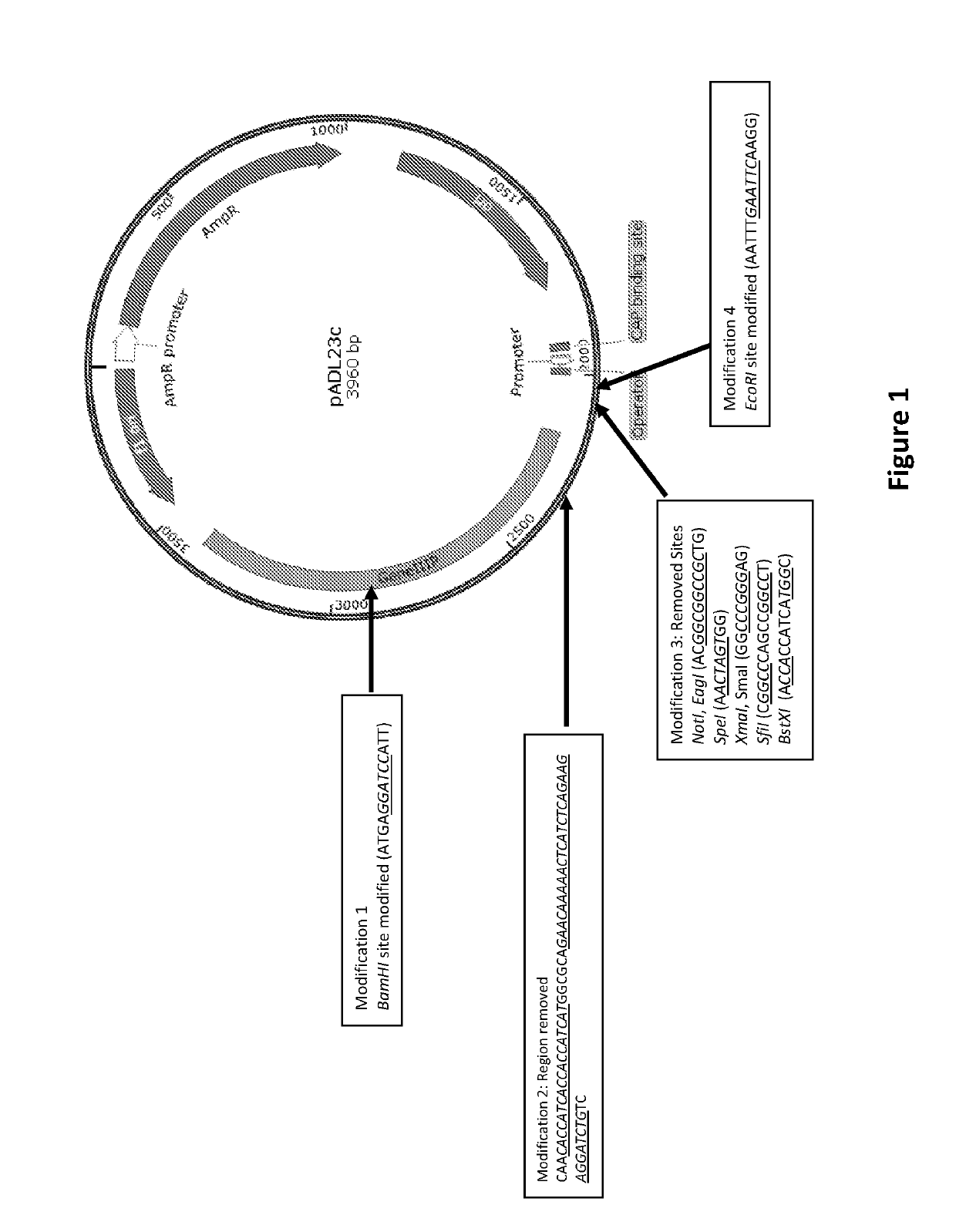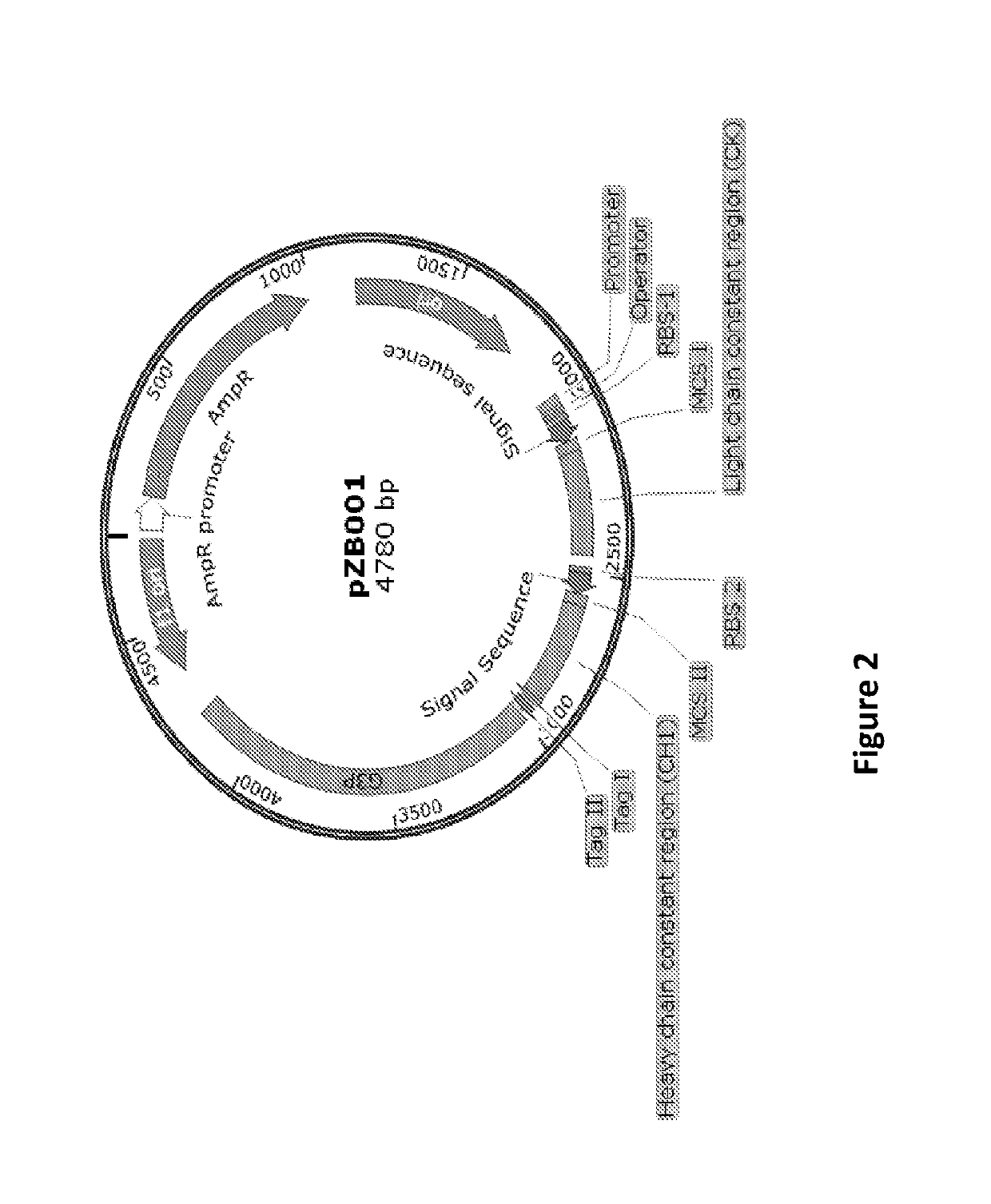Vectors for cloning and expression of proteins, methods and applications thereof
a technology of protein cloning and protein expression, applied in the field of biotechnology, genetic engineering and immunology, can solve the problems of inability to display a single chain protein such as scfv, propensity to aggregate, and difficulty in ribosome display methods
- Summary
- Abstract
- Description
- Claims
- Application Information
AI Technical Summary
Benefits of technology
Problems solved by technology
Method used
Image
Examples
example 1
[0254]General Vector Design Strategy:
[0255]The success of antibody libraries such as naïve or immune or synthetic libraries solely depends on the unique design which has to be diverse and on final library size which should be sufficiently large. Any antibody library size & diversity and antibody specificity & affinity are directly linked. Apart from the crucial design of variable light chain and heavy chain repertoire—synthetic or naïve; development of a system especially different expression vectors to accommodate the large repertoire is extremely important. In addition to the stated fact, aligning the usefulness of each vector strategically is the key feature to successful library generation and screening.
[0256]Current method involves the development of two unique Phagemid vectors in order to accommodate and express antibodies in Fab format with specific modifications designated towards kappa and lambda light chain constant regions along with heavy chain constant region, along wit...
example 2
[0259]Generation of Phagemid Vector:
[0260]To obtain a highly efficient and functionally large protein / peptide library such as antibody library, the following important considerations were taken: 1) Efficient generation of functional and large antibody repertoire with either PCR amplified natural pool or in silico designed and synthetically developed pool of molecules in phagemid vectors; 2) Chosen antibody format and compatible cloning & expression vector, which would permit the rapid downstream analysis of selected clones as exemplified by compatibility with suitable screening method followed by transferring of selected clones for several subsequent characterization experiments.
[0261]In order to accommodate large number of molecules in Fab format, two step cloning method was adopted confirming the presence of both types of inserts i.e., light chain and heavy chain variable regions, at the construction level.
[0262]Herein, the Phagemid vectors are with bicistronic operon having speci...
example 3
[0329]Generation of Antibody Library and Transfer of Library from Phagemid to Yeast Mating Vectors
[0330]5 μg of the kappa and lambda light chain from secondary PCR pool representing the naïve repertoire from healthy human donor along with phagemid vectors (kappa pZB001 and lambda pZB001.1, respectively) are digested with HindIII-HF and AscI at about 37° C. for overnight in a total volume of about 100 μL. The digested samples are gel eluted followed by ligation set up at about 4° C. for overnight. The 25-50 ng of ligation mixture is transformed into about 25 μL of TG1 cells through electroporation wherein 1.0 mm cuvette is used with an optimal setting of 1800 volts, 600 ohm and 10 μF. Post recovery in recovery media, about 200 μL of transformed cells are spread on 144 mm plates and incubated overnight at about 37° C. In total, there are about 6-8 plates from which colonies are scraped on following day and stocks are made with about 20% glycerol. Transformation efficiency is calculate...
PUM
| Property | Measurement | Unit |
|---|---|---|
| total volume | aaaaa | aaaaa |
| volume | aaaaa | aaaaa |
| OD | aaaaa | aaaaa |
Abstract
Description
Claims
Application Information
 Login to View More
Login to View More - R&D
- Intellectual Property
- Life Sciences
- Materials
- Tech Scout
- Unparalleled Data Quality
- Higher Quality Content
- 60% Fewer Hallucinations
Browse by: Latest US Patents, China's latest patents, Technical Efficacy Thesaurus, Application Domain, Technology Topic, Popular Technical Reports.
© 2025 PatSnap. All rights reserved.Legal|Privacy policy|Modern Slavery Act Transparency Statement|Sitemap|About US| Contact US: help@patsnap.com



